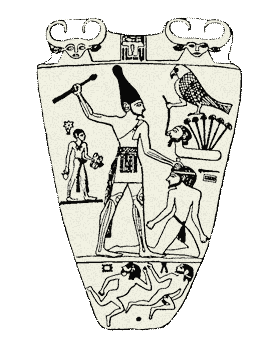"The Gnostic Anthropology, based on precise rules and on Eternal Traditional Principles, knows how to extract, from the archaic stones, all the Esoteric Wisdom."
|
 |
60 centimeters in height, found in a Temple of Nekhen, dates from the year 3100 B. C. It is considered one of the first examples of Egyptian hieroglyphic writing. The Official Anthropology considers that this Palette refers to the battles of the Pharaoh Narmer in the South, to conquer the North, to unite both parts of Egypt under his rule.
But this apparent battle or war scene (including in other cultures where the same basic elements always appear systematically: a king or a warrior who holds one or three characters by the hair in the attitude of beheading them), joined with other symbolic elements that compose it, tell us of Eternal Principles present in many Alchemist traditions.
Thus we have: The Symbol of the cuttlefish, or “nar” and the chisel, or “mer”, because it stands between two oxes, the forces of Ob and Od, are constituted in The Mercury (Water) and in The Sulfur (Fire), fundamental elements of the Great Work.
The Alchemist Purification is represented by the central figure, which, holding with one hand the man knelt in front of him, being ready to eliminate him with the symbol of the phallic force, or the staff which he handles with his right hand, deepens even more the initial meaning of the chisel and the cuttlefish. As a result of these processes of Alchemist Purification and Sublimation, appears above the knelt man, a figure that wears on its shoulders six lotus flowers which, together with its head, are the representation of the seven Bodies of the Authentic Man, or in any case, the seven Degrees of Power of the Fire.
Up above this figure appears and ancient image or Horus who represents the Being, The Innermost, who offers his support to the Egyptian Initiate.
Behind the Initiate, a little man holds some palettes, as a representation of the double phallic power or the double lance of the runes, and on which he keeps the calculations of the work done, as confirmed by the flower (the virtues) on his head and the heart (basis of the superior and inferior things) which holds it in the other hand.
The captive and dying man, together with the other two who run terrified, in the bottom part of the palette are the representation of the Psychic Aggregates or the I-s, which The Initiate must eliminate (the most visible and the most hidden). But going thoroughly into it a little more, we could add that they also represent the expression of those Red Demons of Seth that are situated in the Astral, Mental or Causal substance, thus becoming The Well Known Demons that the “Book of the Dead” mentions: The Demon of Desire (APOPI), The Demon of the Mind (HAI) and The Demon of Ill Will (NEBT), which maintain a connection with the Three Classical Furies or The Three Traitors, which all the Masters that existed in the world had to defeat and eliminate.
Oscar Uzcátegui - "The Gnostic Egypt"
The Materialistic Anthropology, through associations of intellective type, takes out deductions, logical, which may not agree with the principles of Anahuac or of the Toltecs or of Egypt; but the Gnostic Anthropology, based on precise rules and on Eternal Traditional Principles, knows how to extract, from the archaic stones, all the Esoteric Wisdom.
Samael Aun Weor - "AGnostic Anthropology"
Continuing to: The Palette of Narmer (Part II)
|
 Gnostic Anthropology
Gnostic Anthropology  The Palette of Narmer
The Palette of Narmer 

